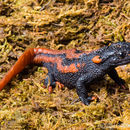fr
noms dans le fil d’Ariane


The red-tailed knobby newt or Kweichow (crocodile) newt (Tylototriton kweichowensis) is a species of salamander in the family Salamandridae. It is found in western Guizhou ("Kweichow" being an old spelling of Guizhou) and north-eastern Yunnan, China.[1] It is most closely related to emperor newt (Tylototriton shanjing) and Himalayan newt (T. verrucosus).[2]
The red-tailed knobby newt is a relatively large, robust newt. Their total length is 155–210 mm (6.1–8.3 in), females being larger than males. They live in small ponds, slowly flowing streams and surrounding shady and moist grassy slopes with many hiding places. Outside the reproductive season, they are rather terrestrial. The reproductive season is from early May to early July, coinciding with the rainy season.[2]
The red-tailed knobby newt has been recorded in Bijie, Dafang, Hezhang, Nayong, Shuicheng, Weining, and Zhijin counties of western Guizhou, and Yiliang and Yongshan counties in northeastern Yunnan (Zhao 1998).[3]
The red-tailed knobby newt feeds on worms, insects, larva, and their smaller newts. They can ingest small frogs and small toads. In captivity they often eat wax worms, mealworms, crickets, and even small fish like guppies.
In captivity they should have a 15-20 gallon tank for housing two or three newts. 5-10 gallon tank is best to house one newt. 40-60 gallon tank for housing 5 or six newts.
The red-tailed knobby newt or Kweichow (crocodile) newt (Tylototriton kweichowensis) is a species of salamander in the family Salamandridae. It is found in western Guizhou ("Kweichow" being an old spelling of Guizhou) and north-eastern Yunnan, China. It is most closely related to emperor newt (Tylototriton shanjing) and Himalayan newt (T. verrucosus).
Tylototriton kweichowensis Tylototriton generoko animalia da. Anfibioen barruko Salamandridae familian sailkatuta dago, Caudata ordenan.
Tylototriton kweichowensis Tylototriton generoko animalia da. Anfibioen barruko Salamandridae familian sailkatuta dago, Caudata ordenan.
Tylototriton kweichowensis est une espèce d'urodèles de la famille des Salamandridae[1].
Cette espèce est endémique de République populaire de Chine. Elle se rencontre entre 1 500 et 2 400 m d'altitude dans l'ouest du Guizhou et dans le nord-est du Yunnan[1].
Son nom d'espèce, composé de kweichow et du suffixe latin -ensis, « qui vit dans, qui habite », lui a été donné en référence au lieu de sa découverte, Kweichow, un autre nom de la province du Guizhou.
Tylototriton kweichowensis est une espèce d'urodèles de la famille des Salamandridae.
Tylototriton kweichowensis é uma espécie de anfíbio caudado pertencente à família Salamandridae. Endêmica da China.
Tylototriton kweichowensis é uma espécie de anfíbio caudado pertencente à família Salamandridae. Endêmica da China.
Cá cóc bướu đuôi đỏ, tên khoa học Tylototriton kweichowensis, là một loài kỳ giông thuộc họ Salamandridae. Chúng là loài đặc hữu của Trung Quốc.
Môi trường sống tự nhiên của chúng là vùng cây bụi ôn đới, vùng đồng cỏ ôn đới, đầm nước ngọt, đầm nước ngọt có nước theo mùa, và ao. Chúng hiện đang bị đe dọa vì mất môi trường sống.
Cá cóc bướu đuôi đỏ, tên khoa học Tylototriton kweichowensis, là một loài kỳ giông thuộc họ Salamandridae. Chúng là loài đặc hữu của Trung Quốc.
Môi trường sống tự nhiên của chúng là vùng cây bụi ôn đới, vùng đồng cỏ ôn đới, đầm nước ngọt, đầm nước ngọt có nước theo mùa, và ao. Chúng hiện đang bị đe dọa vì mất môi trường sống.
Tylototriton kweichowensis Fang et Chang, 1932
Охранный статусКраснохвостый тритон[1] (лат. Tylototriton kweichowensis) — вид амфибий из рода крокодиловых тритонов (лат. Tylototriton) отряда хвостатых земноводных.
Достаточно крупная амфибия — общая длина от 15 до 21 см. Голова имеет овальную форму с чётко выраженными боковыми костными гребнями. Морда закруглена. На туловище выдаются центральный спинной и дорсолатеральные гребни. Пальцы ног лишены перепонок. Хвост сжат с боков, короче чем туловище.
Половой диморфизм выражен слабо. Клоака у самцов более длинная, чем у самок, у которых она имеет округлую форму.
Наиболее замечательная у представителей данного вида окраска — тогда как базовый цвет чёрный, гребни и хвост ярко-оранжевые. Оранжевые пятна так же имеются на голове, этот же цвет имеют пальцы.
Данный вид встречается на западе провинции Гуйчжоу и на северо-востоке провинции Юньнань.
Животные обитают в водоёмах (небольшие пруды, медленно текущие протоки), находящихся в горных районах на высоте от 1800 до 2300 метров над уровнем моря. Часто встречаются на участках, прилегающих к этим водоёмам.
Краснохвостый тритон (лат. Tylototriton kweichowensis) — вид амфибий из рода крокодиловых тритонов (лат. Tylototriton) отряда хвостатых земноводных.
贵州疣螈(学名:Tylototriton kweichowensis)为蝾螈科疣螈属的两栖动物,俗名描包石、苗婆蛇、土蛤蚧,是中国的特有物种。分布于贵州、云南等地,主要生活于高山小流溪、小水塘、周围有杂草或矮灌木以及溪底有淤泥或碎石细沙。其生存的海拔范围为1500至2400米。该物种的模式产地在贵州大定县公鸡山。[1]
贵州疣螈(学名:Tylototriton kweichowensis)为蝾螈科疣螈属的两栖动物,俗名描包石、苗婆蛇、土蛤蚧,是中国的特有物种。分布于贵州、云南等地,主要生活于高山小流溪、小水塘、周围有杂草或矮灌木以及溪底有淤泥或碎石细沙。其生存的海拔范围为1500至2400米。该物种的模式产地在贵州大定县公鸡山。